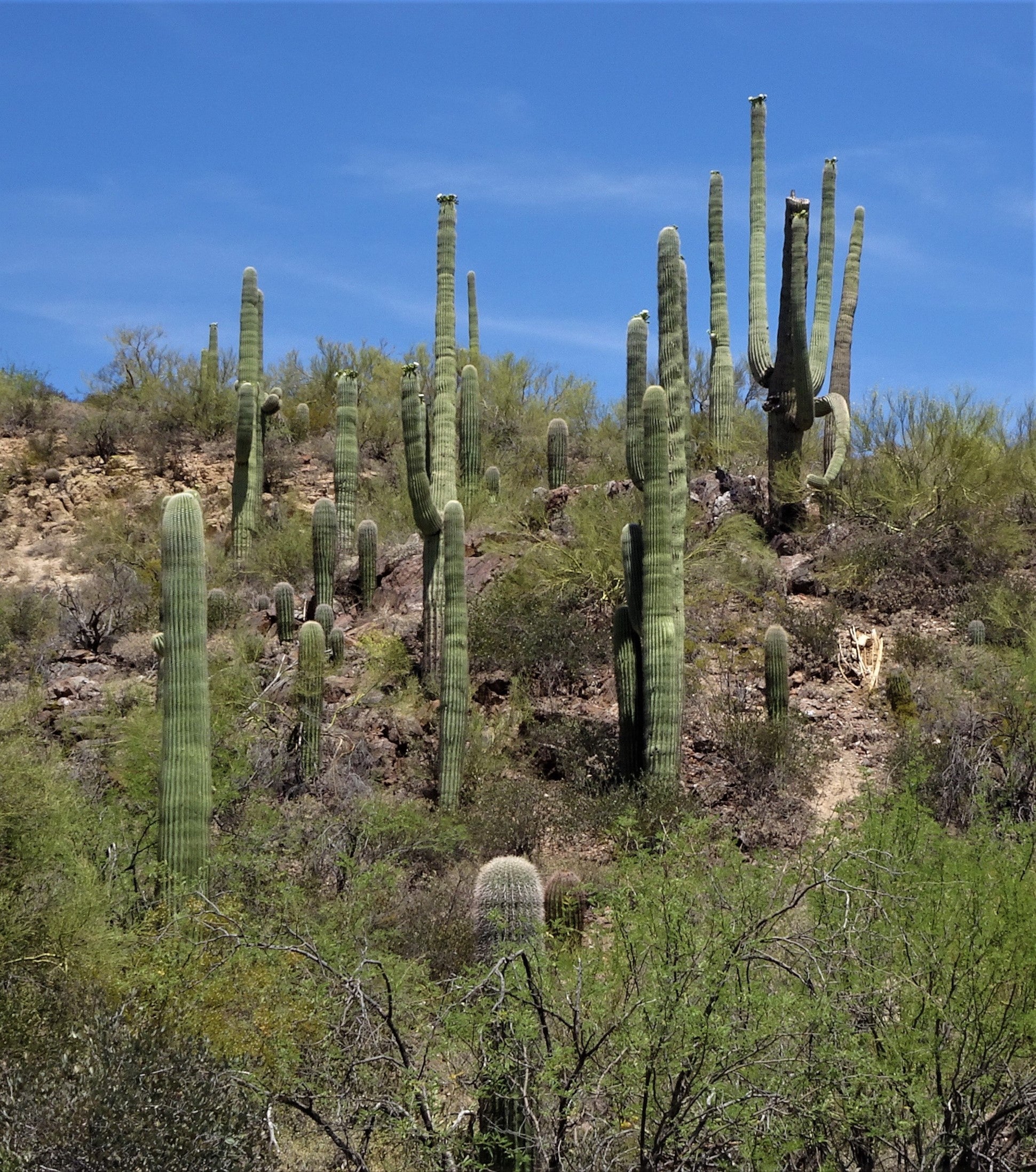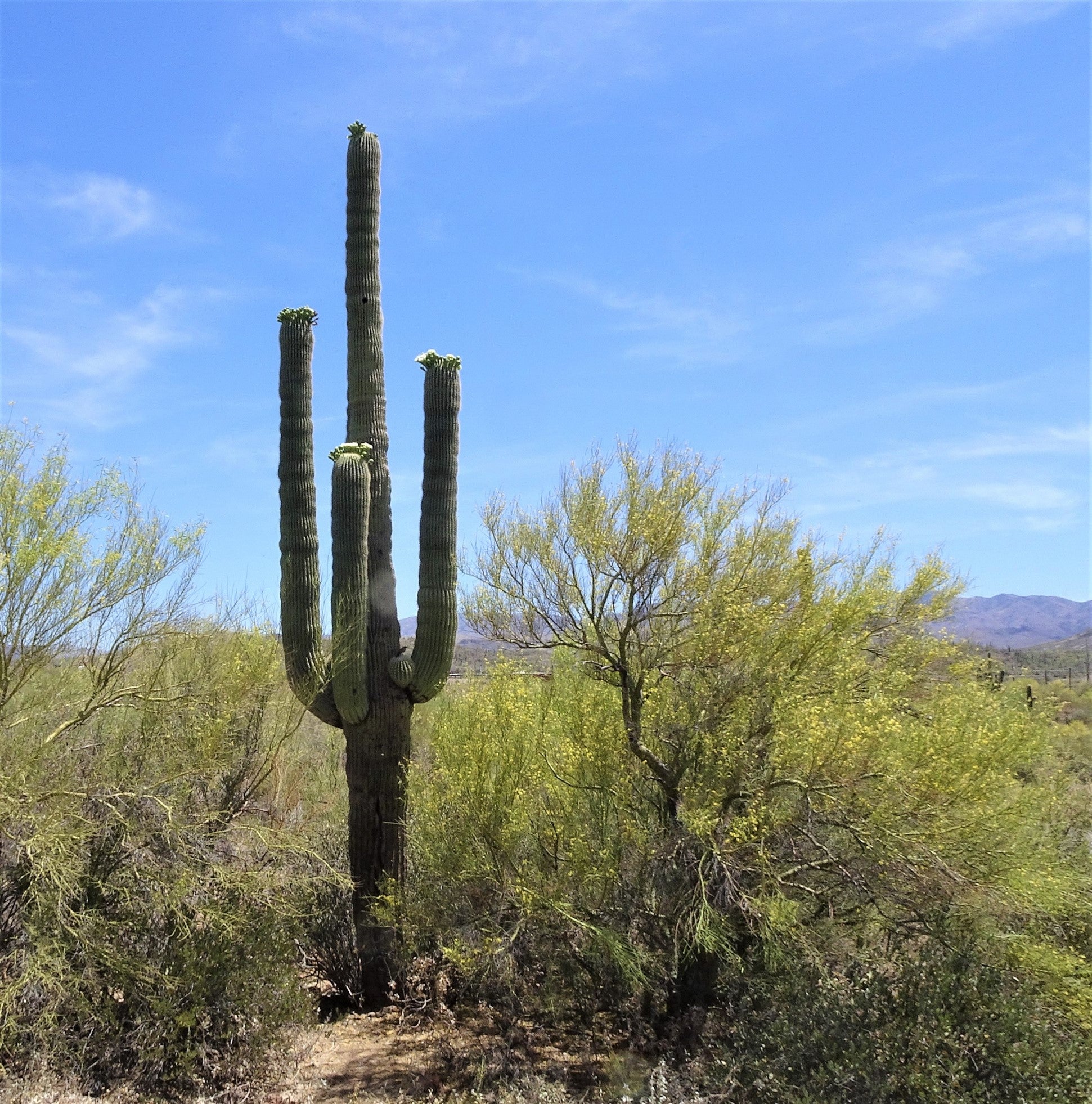The Sonoran Desert
By any standard saguaro cacti are majestic plants, living as long as 200 years and typically growing to 40-50 feet high (the height record is 78 feet). Saguaros can grow as many as 50 or more arms, though usually 10 or fewer.
The presence of naturally growing Saguaros defines the boundaries of the Sonoran Desert, the area where summer rain and winter rain fall in roughly equal measures. There are just a few, less than majestic, specimens eking out an existence on the eastern edges of the Whipple Mountains and Paloverde Mountains in southeastern California. That thin swath of land bordering the west bank of the Colorado River is the only region of California where the proper Sonoran Desert, indicated by the presence of saguaros, exists. Otherwise, southern Arizona in the U.S. and the state of Sonora in Mexico encompass the bulk of where this desert occurs and where you can find naturally growing, self-sustaining stands of saguaro cacti.
Driving east on I-10 from California you can see the rapid transition from the Colorado Desert to the Sonoran Desert; no saguaros border the I-10 freeway in California as you are still in the Colorado Desert, but just 2 to 3 miles into Arizona a few saguaros can be seen. By 10 or so miles east of the Colorado River, saguaros are common statuesque features of the landscape. That desert transition marks a zone where historically summer rain has been more dependable (the Sonoran Desert) and where summer rain is infrequent (the Colorado Desert). In that transition zone, in years when the monsoons are weak or fail to materialize at all, the saguaros suffer.
Like the Mojave Desert’s Joshua trees and the Colorado Desert’s fan palms, saguaros support higher species richness in the regions where they occur compared to areas where they are absent. Hummingbirds, Gila woodpeckers, hooded and Scott’s orioles, white-winged doves, cactus wrens, verdins, and lesser long-nosed bats are all important pollinators. Some are after the pollen and some are after the insects attracted by the open saucer-sized flowers clustered on the arm tips and top of the central column, and some are after both. Saguaro flowers produce abundant pollen, inviting anything that can reach the flowers to a luxuriant, nutritious meal and face dusting of pollen. Gila woodpeckers and gilded flickers excavate their nest sites in the saguaro trunk. The cactus then forms a protective shell of callus tissue around the nest cavity that hardens into what is sometimes called a “boot.” These boot nesting houses then get reused by elf owls, ferruginous pygmy-owls, house finches, purple martins, and others. The branching structure of a mature saguaro can provide a secure nest platform for Harris’ hawks, red-tailed hawks, and ravens. Those stick nests are then reused by great-horned owls. Fallen fruits are consumed by javelina, skunks, ground squirrels. The Sonoran Desert community of organisms revolves around saguaro cacti. Like Joshua trees and desert fan palms, each individual Saguaro provides a multiple species, high-rise apartment
People also use saguaros. Tohono Oʼodham, Pima, and Seri tribes harvest the ripe fruits to be eaten fresh, or dried, or turned to syrup, or a drink. The seeds are ground into a flour for breads. The tall saguaro columns are structurally supported by wooden ribs that run the length of the column. After the cactus dies, those same people use the ribs to construct their homes.
Saguaros are the hub of the Sonoran Desert community, but it’s not just a one-way street – the saguaros benefit as well. An obvious benefit is pollination and seed dispersal. Still, seed germination is very much a challenge for saguaros. The desert heat shrivels cactus seedlings. Those few seedlings that survive were fortunate to have germinated in the shade of a palo verde or ironwood tree. The shading protects the cactus seedlings from heat and being munched on by a squirrel or jackrabbit, and also provides moister soil. The deep-rooted trees’ roots draw up water from many feet below the surface; some of that moisture is transferred to the soil surrounding the roots and that moisture quenches the thirst of the cactus seedlings. The palo verde or ironwood trees, because of their key role supporting the survival of saguaro seedlings, are called nurse plants. Few if any saguaros would survive without them.
The key role saguaros play in supporting the biodiversity of the Sonoran Desert means that anything that threatens these cacti could result in a negative cascade impacting far more than just this single species. The effect of climate change, obviously increasing heat and evaporation, is still uncertain when it comes to saguaros because the effect of climate change on the monsoons is not well understood. If monsoons become stronger and more dependable, the added summer rain could compensate for the added heat. However, if monsoons stay the same or decrease, adult and especially seedling saguaro mortality will certainly increase. Still, an increase in the strength of the monsoons could create a different negative cascade.
A known threat comes from a non-native, invasive plant – buffel grass. Buffel grass (Cenchrus ciliaris) is a perennial bunchgrass (closely related to another desert invader – fountain grass) that can be three feet tall and nearly that wide. It is otherwise native to Africa, but it has been introduced into arid regions, such as Australia and the Sonoran Desert, to support greater livestock, primarily cattle, production across landscapes where cattle would otherwise have little or nothing to eat. Like the saguaros, buffel grass need those warm season monsoon rains. Where and when those rains are a regular, dependable summer occurrence, buffel grass thrives and carpets the Sonoran Desert floor. Good for cattle production but terrible for the biodiversity of the Sonoran Desert. The buffel grass aggressively crowds out native plants and sequesters the precious water needed to support native species. That paints a dire future for the portions of the Sonoran Desert where buffel grass has invaded, but it is worse than that. Buffel grass provides continuous fuels for wildfires. Buffel grass is adapted to surviving and thriving after a wildfire, but none of the native Sonoran Desert species possess similar adaptations. It could take centuries for saguaros to return after a wildfire and then only if the buffel grass is eliminated; they along with their vital nurse plants perish after wildfires, but the buffel grass returns immediately. Dedicated naturalists in the Tucson area work hard to control buffel grass by hand, especially clearing it from the bases of saguaros and their nurse plants, but it is a task without end.
The hyper aridity of the Colorado and Mojave Desert summers is the only thing keeping buffel grass at bay. Desert winds have already brought their seeds here; after an unusually wet summer a few years back I found a handful of buffel grass seedlings growing on the sand dunes within the Coachella Valley National Wildlife Refuge. I picked them and bagged them (and sent them to the UC Riverside’s herbarium). It is sobering to realize that a climate shift could result in so many different and unpredictable and potentially negative outcomes.
Nullius in verba
Go outside, tip your hat to a chuckwalla (and a cactus), think like a mountain, and be safe
For some amazing video, here’s a link to David Attenborough on saguaros.

